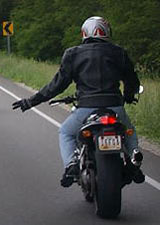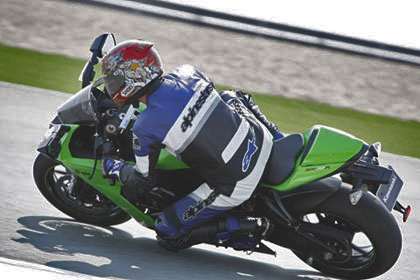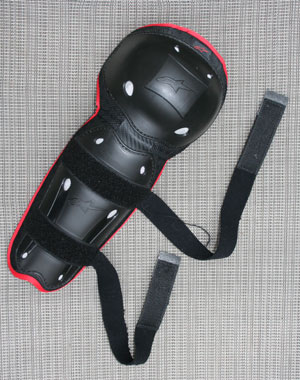If you want to start a raging, multi-page debate in an online motorcycle forum, there are a few old standbys that always work: what’s the best way to break in an engine, what kind of oil should I use, and do I really need to wear all my gear all the time?
It’s the last one of those three that’s most important, in my mind, because what happens to our bodies has a much greater impact on our lives and is much harder to repair than what happens to our motorcycles. Like most things related to riding, I’ve put a lot of thought (maybe too much) into the issue, in an effort to come up with an ideology-free, common-sense, informed and rational approach to what to wear when riding.


Above: On the track, where speeds are higher, good gear is essential: one-piece leathers, racing boots and gloves, full-face helmet and a back protector. (Photo by Kawasaki.) Right: On the street, I choose less technical gear that still provides some protection. (Photo by Bill Andrews.)
Some riders take extreme views on safety gear. Some see helmet laws as “totalitarian enactments,” and react with a visceral opposition that is rarely aimed at laws requiring seat belts or airbags in cars. At the other end of the spectrum are the ATGATT (All The Gear, All The Time) absolutists who will preach to you about the dangers of riding to the corner convenience store while wearing anything less than full leathers.
I’m not here to preach. Just trying to help. My approach to deciding what to wear is based on the conditions of the ride and a hierarchy of my own vulnerabilities.
Priorities, vulnerabilities and preferences in motorcycle gear
I try to apply common sense by establishing a list of priorities based on what I stand to lose. So when I get dressed for any given ride, I start at the top of this list and work my way down until I feel comfortable, based on the ride I’m taking and the conditions.
Helmet: This comes first because without my brain, I’m about as useful to myself, my family and society as a houseplant. Plus, my brain is vulnerable. So my top priority is a helmet. I know some claim to love the wind in their hair. Personally, I don’t. Without a helmet, I feel exposed and vulnerable, bugs feel like shrapnel when they hit my face, my nose gets sunburned and windburned, my eyes dry out and I’m generally unhappy. Your mileage may vary. Your opinion may vary. But this is my top priority. Frequency of use: Always.
Gloves: I’m surprised by how many riders don’t wear gloves, even in cool weather. I like to think I’m not a gear hound, but admittedly I do own a lot of pairs of gloves, because I like my hands to be protected and comfortable in all conditions. In a fall, you naturally put out your hands to catch yourself and in a crash your arms can get whipped around violently. Hands are fragile things and I like being able to dress myself in the mornings. Gloves also protect your hands from sun, wind, rain, cold, suicidal beetles, pebbles bouncing off overloaded gravel trucks, etc. On a trip, I always carry an extra pair. If it’s a time of year when the weather is variable, I’ll probably have three with me: unlined, insulated for cool mornings, and waterproof for cool and rainy moments. Hands that are clumsy from the cold reduce our ability to control the motorcycle. It takes feel and fine movement to operate brakes, throttle and clutch optimally. Frequency of use: Always.
Jacket: I have plenty of essential organs in the upper half of my body, and lots of skin I don’t want to risk being ground away by asphalt, so unless I’m literally just riding around the block, I wear a real motorcycle jacket that provides abrasion protection and protective armor in the elbows and shoulders. Most jackets come with foam back pads, but I have upgraded those to CE-approved back pads that fit in the pockets in the back of the jacket. These back pads are less expensive and more widely available than they used to be and one pad can be used in two different jackets, in my closet.
Some ATTGATTistas will insist that only leather will do. While I always wear a one-piece leather suit on the track, I find textiles are more practical and versatile on the street. They may (emphasize, may) provide less abrasion resistance than leather. But in a street environment, the likelihood of a long slide on asphalt without hitting something, whether a car, a curb, a guardrail, whatever, is smaller. So I’m more concerned with having armor for the impact than an incremental increase in abrasion protection. In temperatures above the high 80s, I wear mesh jackets that let the air flow through whenever I’m moving. They make a huge difference in comfort. Some purists say they don’t provide enough protection, but for me it’s a tradeoff I’m willing to make. But unless I’m taking a very short ride at low speeds in hot weather (a rare combination), I wear a jacket of some kind, at least mesh. Frequency of use: Virtually always.
Boots: True motorcycle boots (not fashion boots designed to imitate the look from an old Marlon Brando poster) provide armor to protect your ankle. Sophisticated racing-style boots also have shin plates and provide support that can prevent twisting or hyper-extension of the ankle. While I think a jacket is more important, I see little drawback to wearing boots, so I always wear purpose-built motorcycle boots, though I’ll pass on the higher protection of the racing-style boots if I’m going to be walking much. Frequency of use: Always.

Alpinestars Reflex Kneeguards.
Pants: Full-on motorcycle pants provide abrasion-resistant materials, armor in the knees, padding in the hips and possibly a waterproof, breathable liner (such as GoreTex). On occasion, when I’m running errands around town, going in and out of stores and wanting to look more “normal,” I wear regular jeans with some on-the-body armor underneat, such as the Alpinestars Reflex Kneeguards shown at right or another pair of soft kneepads with more flexible CE-approved armor. I’ve had knee surgery once and it’s an experience I particularly want to avoid repeating. The kneeguards strap into place and provide impact protection. I’m giving up the abrasion protection of true riding pants, but one of the drawbacks of riding pants is that if they are loose the knee protection can shift around, and may not be where you need it when you need it. These kneeguards give me a lot more confidence that they will stay put. Frequency of use: Motorcycle pants, most of the time; kneeguards, whenever I’m wearing jeans.
One-piece racing leathers. These are for track days. On the street? Overkill and underversatility. I want pockets, ability to adjust for temperature, and comfort. I also have a bigger and more protective back protector I wear under my leathers at the track. Frequency of use: Only on the track.
So for a long ride where I know I’ll be riding at higher speeds, I’ll wear all of the above except the track-only gear. To ride a few blocks to the hardware store, I may skip a few items. I know it’s possible to have a life-threatening crash even at low speeds and on a short trip, but I make tradeoffs for comfort and convenience and I’ll accept the consequences, if it comes to that.

On tour, I like to wear textile gear that is comfortable and versatile and weatherproof while still providing full protection. (Photo by Brian J. Nelson.)
Of course choosing gear is not just about protection. It’s also about comfort. Getting soaked is no fun and shivering remains the least enjoyable cardio workout I’ve ever tried. Fortunately, today’s gear is so good, it doesn’t cost a fortune to stay comfortable and reasonably well protected.
Maximum versatility, minimum expense
If you mostly ride on warm days, here’s a tip on how to get the maximum comfort and versatility out of the smallest possible expenditure on gear. Buy one of the mesh jackets with built-in armor. In hot weather, air flows right through them (if you’re moving), so you’ll stay cool and will have protection from sunburn, as well as road rash if something goes wrong. Then buy a rain suit made specifically for motorcycling. (The stuff made for sitting in the stands at a football game will likely be ripped apart quickly by the wind if you wear it while riding.) If the weather turns chilly, even if it’s dry, you can put on the rain suit over the mesh jacket, which blocks the air flow and keeps you surprisingly warm if that hot afternoon turns into a cool evening. It’s like turning off the air conditioning.
There are great places to buy closeout merchandise online, gear that’s perfectly good but may be last year’s style. Check to see what specials your local dealer has, too. If you shop wisely, a DOT-approved full-face helmet, leather riding gloves, mesh jacket and rain suit can easily be had for around $300. Some people spend that much to fill up their full-size pickups three times, and the gear will likely last you for years. That gas in the pickup surely won’t.
If you can afford a motorcycle, you can afford enough gear to allow you to ride it safely.
Make informed choices, take responsibility
To me, the bottom line is this: It’s about making informed choices, taking personal responsibility, and recognizing the rights of others to make their own decisions, based on their own risk calculations. If you’re an ATTGATT purist, I won’t laugh at you when you’re sweating in your full leathers in a 90-degree traffic jam and I hope you won’t laugh at me if I crash in my mesh jacket and end up with some rash that leathers would have avoided. If you’re a wind-in-your-hair absolutist who won’t ride in a state that requires helmets, then I’ll respect your right to make your own choices, but don’t call me a traitor to the cause because I wear a full-face helmet or lecture me with pseudo-scientific misinformation about helmets causing injuries. In other words, live and let live, make your choices and accept the consequences without whining (or suing someone) and, above all, enjoy the ride.
